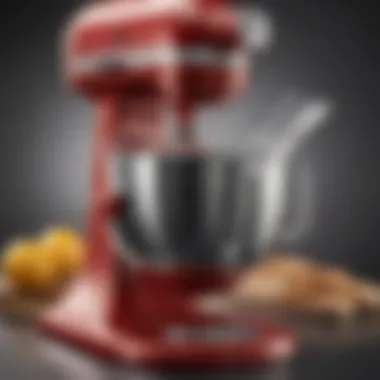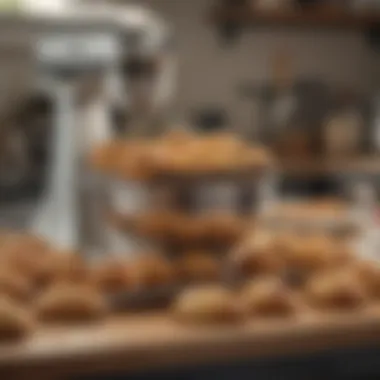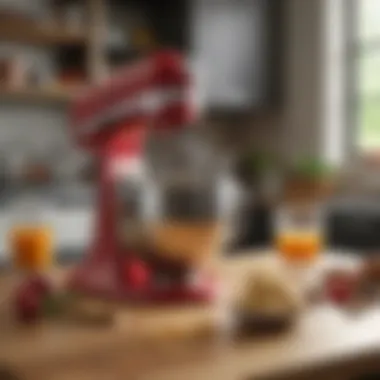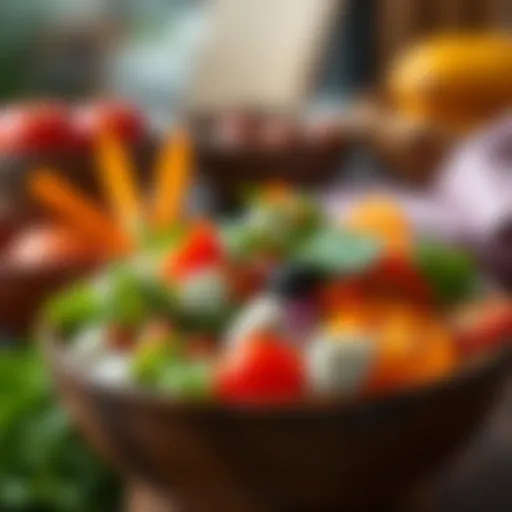Mastering the KitchenAid Stand Mixer Paddle


Intro
KitchenAid stand mixers have become synonymous with efficiency and versatility in kitchens worldwide. Among their array of components, the mixer paddle stands out as a key player, performing a multitude of tasks with finesse. Whether you're an occasional baker or a seasoned culinary artist, understanding the functionalities and nuances of the KitchenAid paddle can elevate your cooking experience. It's not merely a mixing tool; it’s a partner in creating delicious baked goods and everyday dishes. This section will unravel the significance of the paddle in the broader context of cooking, its design choices, and the impact it has on the outcome of various recipes.
Recipe Overview
In order to effectively demonstrate the paddle's versatility, let’s delve into a practical example that any home cook will appreciate. The following recipe highlights the paddle's effectiveness while showcasing its compatibility with different ingredients and techniques.
Recipe Name
Classic Vanilla Buttercream Frosting
Cuisine Type
Baking
Ingredients
List of Ingredients with Measurements
- 1 cup unsalted butter, softened
- 4 cups powdered sugar
- 2 teaspoons vanilla extract
- 2-4 tablespoons heavy cream or milk
Substitutions for Common Ingredients
- For a dairy-free option, substitute 1 cup coconut oil for butter
- Use agave syrup or honey instead of powdered sugar
- Instead of vanilla extract, try almond extract for a different flavor profile
Knowing how to utilize the KitchenAid stand mixer paddle effectively can influence the consistency and brightness of your frosting. This article aims to equip you with insights that enhance your kitchen practices, ensuring every mixing endeavor leads to successful culinary creations.
The Importance of the KitchenAid Stand Mixer Paddle
The KitchenAid stand mixer paddle holds a pivotal role in the world of culinary endeavors, acting as the backbone for countless favorite recipes. Understanding its significance extends beyond just knowing what the paddle is; it involves comprehending how this humble tool affects the overall mixing process, impacts texture, and facilitates a range of kitchen activities. It’s not just a tool; it’s an enabler of culinary success.
Understanding the Role of the Paddle
The paddle attachment is designed specifically for mixing heavy batters, doughs, and other thick mixtures. When you engage in baking or cooking, the paddle’s unique shape and functionality allow for thorough mixing. It evenly incorporates ingredients without overworking, ensuring a balanced final product.
The paddle is often considered the workhorse of the stand mixer, essential for baking enthusiasts and home chefs alike.
Types of Mixing Tasks
The versatility of the KitchenAid stand mixer paddle can't be overstated. Here, we'll delve into the specific tasks it excels at, illustrating its crucial place in any cook’s arsenal.
Mixing batters
Mixing batters is perhaps the most common use of the paddle attachment. This task requires a steady hand and a reliable tool to bring together flour, sugar, and wet ingredients seamlessly. The paddle provides an efficient means to blend these components without creating overly tough mixtures—which can often happen if one were to knead by hand or use a brush.
The key characteristic of mixing batters is its ability to aerate while blending, making the paddle a popular choice. The unique features offered by this attachment mean that it can handle both dense cookie doughs and lighter cake batters. This adaptability is a significant advantage, simplifying the approach to varied recipes.
Whipping cream
While the traditional whisk might spring to mind for whipping cream, the paddle attachment has its moments too. Though less common for this task, it can still whip cream effectively, particularly when large batches are involved. The paddle facilitates the incorporation of air, leading to a light and fluffy texture.
One of the key advantages here is the speed at which whipping occurs—driving a mixer with a paddle can save time in preparation. However, one must be careful; the paddle could inadvertently over-whip cream, leading to a somewhat grainy texture if not monitored closely.
Folding ingredients
Folding ingredients is another crucial mixing task where the paddle shines—particularly when combining lighter elements, like whipped cream, into heavier mixtures. This method works well for batters requiring a gentle hand, as the paddle's design allows it to scoop underneath and lift, rather than stir vigorously.
In this context, the paddle's gentle action offers significant benefits. It's that perfect balancing act, ensuring delicate ingredients maintain their structure while actively promoting an even mix.
In summary, every kitchen enthusiast should appreciate the wide range of tasks that the KitchenAid stand mixer paddle can handle. From mixing batters and whipping cream to gently folding ingredients, this tool lends itself to diverse applications, making it not just a luxury, but a necessity in the culinary toolkit.
Design and Construction of the Paddle
When we think about the KitchenAid stand mixer, it’s essential to consider the paddle. This tool isn't just an accessory; it's a cornerstone of many kitchen tasks. The design and construction of the paddle play a pivotal role in the mixer’s overall efficiency and functionality. Every chef’s secret weapon is often not the recipe itself, but the quality and design of the tools they use. That's why understanding the specifics of paddle design can elevate culinary creations, whether baking a cake or whipping up a batch of mashed potatoes.
Material Composition
Plastic vs. Metal
The choice between plastic and metal paddles can stir up quite a discussion among culinary enthusiasts. Each material brings its own set of characteristics that can influence mixing performance.
Plastic paddles are lightweight, easy to handle, and generally more affordable. They're particularly useful for mixing softer batters and doughs. However, they may not stand up to heavy-duty tasks as well as their metal counterparts. The flexibility in design allows for more creative options but bear in mind that plastic can warp over time, especially with exposure to high heat.
In contrast, metal paddles are built to last and are sturdy enough for regular heavy use. They provide a stronger mixing experience and can tackle dense mixtures without losing shape. On the downside, they can be a tad heavier and may scratch non-stick surfaces if not treated carefully.
Thus, the decision often boils down to individual preferences and the specific mixing tasks at hand.


Coated Paddles
Another option worth discussing is coated paddles, which typically feature a non-stick surface. This design is advantageous for effortless mixing and easy cleanup. The coating reduces batter sticking, which not only speeds up the mixing process but also cuts down on the frustration of scraping every last bit off the paddle.
However, these coated paddles can also be prone to scratching, especially if you’re using metallic utensils against them. It’s essential to employ tools that are gentle on the surface to maintain their longevity. The coatings do add a layer of protection, but they may not last forever, necessitating careful cleaning and handling.
Shape and Size
Standard Paddle
The standard paddle is the tried-and-true option for most mixing tasks. Its design allows for a thorough mixing action that can fold ingredients smoothly while also aerating batters quite effectively. Many bakers swear by the reliable nature of standard paddles for day-to-day baking. One of their key characteristics is the ability to operate without much fuss, making it easy for even the most novice cooks to achieve consistent results. However, in cases of thicker doughs, you may need to stop and scrape the sides, as this paddle might leave a little more residue than others.
Flex-edge Paddle
The innovative flex-edge paddle takes mixing efficiency up a notch. This design features a flexible edge that scrapes the bowl as it mixes. As a result, this paddle reduces the need for manual scraping during the mixing process. The flex-edge paddle is particularly beneficial for batters that tend to cling to the walls of the bowl, ensuring a uniform consistency throughout.
Though this paddle shines in versatility, it may be more challenging to clean due to its intricacies. The intricate design does add some complexity, but for those who value efficiency, it’s often worth the effort.
Wire Whip Paddle
Often seen as a luxury for those who enjoy airy textures, the wire whip paddle is designed for a different purpose altogether. This paddle enhances aeration, making it the top choice for whipping cream and egg whites to lofty peaks. Its unique and open design catches air effectively during mixing, which is crucial for certain recipes like meringues or soufflés.
On the other hand, it won’t perform well with heavy doughs, so it’s not as versatile in that regard. Instead, it's tailored for those light and fluffy creations that require the kind of mixing power found in traditional whipping motions.
In summary, each paddle serves a unique purpose depending on the intended task. By understanding these differences in material and shape, one can make informed choices that complement their cooking style, ensuring greater success in the kitchen.
Compatibility with KitchenAid Models
The compatibility of the KitchenAid stand mixer paddle with various mixer models is crucial for maximizing the functionality and versatility that this kitchen appliance offers. Understanding which paddles fit specific models can save time and frustration in the kitchen. When you invest in a KitchenAid mixer, you want to make sure you're equipped with the right tools that enhance your culinary experience. Without proper compatibility, mixing can become inconsistent, leading to subpar results in your recipes.
Identifying Compatible Models
Not all KitchenAid mixers are created equal, and this holds true for their paddles as well. Each model has its specific features and requirements. To avoid any mishaps, it's wise to check which paddle fits your mixer. A few key points to keep in mind include:
- Model Variations: KitchenAid stand mixers come in several models like the Classic, Artisan, and Professional series. Each has distinct paddle design parameters that influence compatibility.
- Attachment Availability: KitchenAid often releases new attachments or paddles for different models, which can lead to confusion. Always refer to the manufacturer's manual or website for clarity.
- Size Matters: A paddle that's slightly too large or small can hinder performance. It's essential to measure and compare accordingly.
Accurately identifying the right paddle ensures efficient mixing and prevents damages that can arise from using incorrect tools.
Adapting Paddles for Attachments
When it comes to mixing, versatility doesn't just end with the paddle itself. Adapting these paddles for specialty attachments and different mixing bowls broadens the horizons of what you can whip up in your kitchen. Here are two specific areas to consider:
Specialty Attachments
Specialty attachments are designed to enhance the capabilities of your KitchenAid stand mixer. These might include pasta makers, food grinders, or spiralizers. Each attachment has its unique aspects:
- Key Characteristic: Specialty attachments allow cooks to experiment with diverse cooking techniques and ingredients that you wouldn't typically handle with a standard paddle.
- Benefits: They offer a blend of convenience and efficiency. For instance, the pasta maker attachment can produce fresh noodles in no time, making it an inviting choice for those who enjoy Italian cuisine.
- Unique Features: Some attachments can dramatically change the texture and consistency of your mixtures. For example, the grinder attachment lets you control the coarseness of your ground meat, enabling you to customize burgers or meatloaf to your liking. However, they may require extra cleanup, which could be a downside for some.
Mixing Bowls
Mixing bowls also play an integral role in the efficiency of the paddle. The right bowl can significantly influence the outcome of your mixtures:
- Key Characteristic: Mixing bowls come in various capacities and materials, including glass, stainless steel, or plastic, each serving a different purpose. For instance, glass bowls are great for monitoring mixture progress visually, while stainless steel might be better for heavier doughs.
- Benefits: Using the appropriate bowl size for your recipe can facilitate better mixing. For larger recipes, a bigger bowl means you won't need to make multiple batches, saving time and effort.
- Unique Features: Certain mixing bowls are designed to fit snugly with the stand mixer. This feature reduces the likelihood of splatter, which can be a significant advantage when whipping cream or mixing batter.
Proper Maintenance of the Stand Mixer Paddle
Maintaining the KitchenAid stand mixer paddle is not just about keeping it clean. It’s about ensuring the mixing performance is at its peak, and can withstand the test of time. By understanding the various aspects of proper maintenance, you can enhance your cooking experience, protect your investment, and ultimately turn out better culinary creations.
Cleaning Techniques
Handwashing versus dishwasher
When it comes to cleaning your stand mixer paddle, the choice often boils down to handwashing or using a dishwasher. Handwashing allows you to give the paddle a careful scrub, ensuring every nook and cranny is free from residue. This method often feels more gentle, which is a key characteristic if you're concerned about the longevity of the paddle. It’s like treating your favorite pair of shoes with a good polish, versus tossing them in a laundry machine.
On the flip side, using a dishwasher sure has its perks. It offers convenience and saves you time, allowing you to clean multiple items in one go. However, the high heat and harsh detergents can sometimes be a bit too aggressive, potentially leading to wear over time. So, if you value ease, you might lean towards the dishwasher, but if you prioritize care, you might choose to handwash your paddle.
Removing tough residues
Over time, your paddle may accumulate stubborn residues, especially if you've been hard at work mixing sticky batters or creamy frostings. Removing these tough residues is essential not just for hygiene but also to maintain the performance of the paddle. A common method involves soaking the paddle in warm, soapy water, which helps to loosen those stubborn remnants.
Another effective technique is using a baking soda paste, which acts as a gentle abrasive. This method stands out for its effectiveness, making it a popular option among chefs who demand precision in their kitchen tools. Just make sure to rinse thoroughly afterward, as leftover baking soda can leave an undesirable taste in your next culinary attempt.
Storage Solutions
Organizing mixing tools
Storing your mixing tools like the KitchenAid paddle in an organized manner is key for quick access during your cooking sessions. Imagine this: searching around your kitchen for a tool you need mid-recipe can be a real hassle. By keeping everything neatly arranged, you save time and minimize the chances of accidents, like dropping a paddle into a mixing bowl full of batter.
Using a dedicated drawer or a wall-mounted rack are excellent options to keep your tools in line. This not only enhances functionality but it also adds a degree of flair to your kitchen. Plus, storing them properly helps ensure they don’t get scratched or damaged, keeping them raring to go for your next baking adventure.


Preventing damage
Taking proactive steps to prevent damage to your mixer paddle is crucial. One simple yet effective approach is to store it in a padded compartment or with a protective cover. This keeps it safe from being knocked around with other heavy tools. Just like a prized painting is best stored away from sharp corners, your mixer paddle deserves that same level of care.
Additionally, avoiding extreme temperatures is vital. Don't let your paddle hang out in direct sunlight or in a cold, damp spot, as these conditions can warp materials or create unexpected stains. By taking these small steps, you're ensuring a longer lifespan for your paddle, ultimately enhancing your KitchenAid experience.
Practical Tips for Effective Mixing
In the realm of culinary arts, the details often make all the difference. Having a KitchenAid stand mixer is like having a trusty sidekick in the kitchen, but knowing how to effectively use the paddle is crucial. Mixing isn’t just plugging in a machine and pressing a button; it’s an art form as well as a science. With a few practical tips, you can elevate your mixing game, ensuring consistency and quality in your recipes. Let’s delve into some key elements, their benefits, and considerations to keep in mind.
Adjusting Mixing Speeds
Starting slow
When it comes to starting your mixer, taking it slow is not just a suggestion; it's wisdom carved in flour and sugar. By beginning on a lower speed, you minimize the risk of splatter, ensuring that your ingredients merge seamlessly rather than becoming a flour storm. One key characteristic of starting slow is that it helps incorporate dry ingredients like flour into wet ones without creating a cloud of dust.
Moreover, this method is a beneficial choice for this article because it caters to bakers of all skill levels. Beginners may find it less intimidating, while seasoned chefs appreciate the controlled incorporation it offers, reducing the likelihood of overworking the batter. The unique feature of beginning at a slow speed lies in its ability to blend ingredients gently, resulting in a consistent texture without sudden shocks that could deflate lighter mixtures.
However, it does come with drawbacks; it might lengthen the overall mixing time. Yet, the initial investment in patience often pays off with better results. In short, starting slow ensures a sturdy groundwork for your batter or dough.
Building to higher speeds
Once your ingredients have embraced one another at the lower speeds, it becomes time to ramp things up. Building to higher speeds is where the magic often happens. Increasing the speed allows for air to be trapped into your mixtures, which is especially crucial when you're whipping cream or achieving that perfect cake batter. The key characteristic here is that speed enhances the aeration process, resulting in fluffer outcomes.
Choosing this method is popular among many chefs highlighted in this article due to its efficiency; after achieving an initial blend, you can quicken your pace without losing the quality of the mixture. A unique feature of building to high speeds is the heightened effectiveness in achieving the desired texture, especially in sponge cakes or soufflés, which rely heavily on that incorporated air.
Nonetheless, caution is key. If you crank it up too quickly, you run the risk of splattering ingredients everywhere, and nobody wants to clean a mess. In the end, the judicious transition from slow to fast can lead to culinary triumph.
Timing for Optimal Results
Recognizing mixing signs
Just as every artist knows when to put down the brush, every cook must learn to recognize the signs that their mixture is ready. This segment revolves around keen observation—from the texture to the sound of the mixer. The signals might seem subtle at first, but honing this skill can significantly contribute to the end goal of creating delicious baked goods.
A key aspect of recognizing these signs in the context of this article centers on the way textures change. For instance, when dough reaches a level of smoothness or when whipped egg whites become glossy, you’ll know you are on the right track. It’s a beneficial trait that can save both time and ingredients. The unique feature here is that being attuned to these signs helps in ensuring that all your mixtures achieve their designed textures without over-processing, which could compromise the delicate balance often sought in baking.
Preventing over-mixing
Lastly, let’s talk about the troublesome topic of preventing over-mixing. This issue can turn what could've been a delightful cake into a dense disaster. Recognizing that less can be more is essential in this culinary adventure. The key characteristic of preventing over-mixing lies in its role in maintaining the structure you want in your baked goods—especially cakes and muffins which thrive on a tender crumb.
Being aware of the right mixing duration tailors the work of the paddle to ensure that gluten development doesn’t go rogue. It stands out as a popular choice for many seasoned chefs, particularly in this article, because it preserves the integrity of your mixture and avoids the unwelcome chewiness that often comes from excessive mixing. The unique advantage of this tip is its simplicity; measuring the time your mixture takes and listening to the sounds it makes can prevent a world of baking heartaches.
In summary, these practical tips for effective mixing are foundational elements that go beyond just using a KitchenAid stand mixer paddle. They provide valuable insights that lead to the creation of beautiful, delicious results, whether you're a novice baker or an experienced hands-on chef. With each tip, you can refine your skills, ensuring that your culinary creations sing with flavor and texture.
Recipes to Test Paddle Functionality
Understanding how to effectively use the KitchenAid stand mixer paddle isn’t just about knowing its parts; it’s about seeing it in action with recipes that demand varying techniques. Cooking isn't merely a craft, it's an art, and testing the paddle's functionality through practical recipes sharpens your skill set. By employing different mixing tasks, you can discover what works best for your culinary needs while also enjoying the fruits of your labor. This section showcases three key recipes that help illustrate the paddle's versatility and functionality, from simple cookie dough to creamy mashed potatoes.
Classic Chocolate Chip Cookies
When thinking of a quintessential recipe for testing your KitchenAid stand mixer paddle, you can’t go wrong with classic chocolate chip cookies. These beloved treats are more than just a nostalgic comfort snack; they present an excellent opportunity to see the paddle’s efficiency at its finest.
The entire mixing process begins with butter and sugars. Creaming these together requires a steady hand and an understanding of speed. Using a moderate speed on the mixer allows you to thoroughly combine the ingredients without sending them flying everywhere. Expect a light, fluffy batter as a result.
Once the eggs and vanilla get included, the paddle's versatility shines through the folds and mixes without overworking the dough. Then, in go the dry ingredients. The key here is to keep the mixer on a lower speed to prevent any flour explosions. If you’re not careful, you'll end up dusting your kitchen. The benefit of using the paddle attachment is that it minimizes lumps while maximizing that soothing cookie aroma that fills the air. Here are some considerations:
- Ingredients: Always use fresh baking soda and good quality chocolate.
- Technique: Alternate adding wet and dry ingredients for better incorporation.
- Baking Tip: Monitor the cookies closely while baking; they can go from perfect to burnt in a matter of minutes.
Fluffy Cake Batter
Another classic recipe that puts the KitchenAid paddle to work is that of a fluffy cake batter. Whether it’s a birthday or a simple Sunday gathering, a well-made cake leaves a lasting impression. For this, a precise texture is essential — something that a paddle excels at achieving.
Starting with room temperature butter and sugar, the creaming process is vital. It’s this step that creates that light texture, which is crucial for a cake. The paddle does the job beautifully, ensuring air pockets are made so that the cake rises evenly during baking. Once the eggs enter the ring, they should be added one at a time, allowing each to integrate fully before the next is introduced.
Adding flour and liquid alternately keeps the batter smooth and aids in proper emulsification. Don’t rush through this; a bit of patience goes a long way. Here’s a way to streamline the process:
- Pre-measure your ingredients to keep a steady rhythm.
- Scrape the sides of the bowl as needed to ensure even mixing.
- Test for doneness with toothpicks; that’s the final, satisfying touch before enjoying a piece of your creation.
Mashed Potatoes
Lastly, we can't overlook mashed potatoes — a staple in many kitchens and another great opportunity to test the paddle's capability. This recipe is simple, but it brings out the best in your stand mixer. The secret is in how you prepare the potatoes before they get mixed.
Boiling the potatoes until tender is paramount; undercooked potatoes will lead to a chunky, uneven mash. Once drained, the real magic begins. Adding warm milk and butter to the mixer creates that velvety texture everyone craves. Using the paddle attachment instead of a standard hand mixer gives you more control over the final product.
Here are some key points:
- Warm Ingredients: Always incorporate warm milk and butter; cold additions make for a rubbery end.
- Timing Matters: Mash until you reach your desired consistency, but be careful not to over-mix — you want creamy, not gummy potatoes.
- Flavor Enhancements: Consider herbs or garlic for an added twist.


Establishing a repertoire of recipes like these provides greater insight into the versatile applications of your KitchenAid paddle. By practicing with each recipe, you'll not only master different mixing techniques but also elevate the quality of your kitchen triumphs.
Common Issues and Troubleshooting
Addressing common issues with the KitchenAid stand mixer paddle is crucial for ensuring smooth culinary experiences. Understanding potential problems not only eases frustration but also prolongs the life of the mixer. Common issues can lead to inefficient mixing or, worse, damage to the machine. Thus, knowing how to tackle these challenges is essential for anyone looking to maximize their stand mixed endeavors.
Paddle Not Mixing Properly
When a paddle isn't mixing correctly, it can throw a wrench in the works of any recipe. It's important to pinpoint the cause, which often boils down to the paddle's alignment or its wear and tear.
Checking alignment
Checking alignment might seem like a no-brainer, but it’s often the first thing to overlook. Aligning the paddle correctly plays an essential role in how effectively it interacts with ingredients. A misaligned paddle won't scrape the bowl's edges properly, leading to uneven mixing. The key characteristic of proper alignment is that it ensures the paddle contacts all parts of the mixing bowl, providing even distribution.
To visualize it, think of a train running off the tracks; it doesn’t go smoothly. The same applies here. If you find your paddle isn’t precisely aligned, simply detach and reposition it, taking care to tighten any screws that hold it in place. This approach is popular among seasoned bakers and is a beneficial first step for anyone experiencing mixing issues.
Advantages of checking alignment include:
- Ensures all ingredients are incorporated
- Helps to avoid overworking the mixer
Disadvantages could include the need for regular adjustments if the mixer is frequently taken apart, leading to potential wear on the attachment points.
Examining paddle wear
Paddle wear should never be dismissed, as it can significantly impact performance. A worn paddle won’t only produce subpar batters and dough but may also damage your mixer over time. Key features of a well-maintained paddle include smooth edges and a solid structure. When inspecting for wear, look for cracks, chips, or discoloration that could signify it's past its prime.
It's a good practice to regularly assess your paddle's condition, especially after heavy use. If you notice any significant wear, it might be time for a replacement. Exchanging a damaged paddle is a proactive choice, promoting better outcomes in your mixing tasks.
Advantages of examining paddle wear are:
- Prevents further damage to the mixer
- Ensures consistent mixing quality
On the flip side, replacing paddles can add to kitchen costs, and you might find yourself needing to buy multiple paddles for various tasks, which can clutter your kitchen tools.
Noise During Operation
A noisy mixer can quickly grab your attention, signaling that something isn’t quite right. Understanding and addressing the root causes can save you headaches down the line. Common culprits often relate to loose parts or underlying motor issues, both of which need timely attention.
Identifying loose parts
Loose parts can be tricky to detect, but they typically manifest as rattling or clattering noises. This aspect is essential because loose components can create misalignment in how the paddle operates. Identifying loose parts is often a straightforward fix—simply tighten any visible screws or components. This simple maintenance task can make a world of difference.
Many learners or novice cooks overlook this, but it’s a beneficial habit to check for loose parts regularly, especially if you mix heavier batters. The bottom line? Tightening your mixer can preserve its longevity, keeping your kitchen quiet.
Advantages of identifying loose parts include:
- Restores optimal mixer performance
- Reduces risk of further damage
Disadvantages might include the need for occasional upkeep, which, if ignored, could compound into more severe issues later.
Addressing motor issues
Sometimes, noise can indicate deeper motor problems that need urgent attention. A humming or grinding sound can suggest that your mixer is struggling to function efficiently. Addressing motor issues is crucial for long-term mixer health; neglect can lead to complete failure.
A particular aspect of this issue is recognizing when to consult a professional. If the noise persists even after checking for loose parts, it could be time to contact KitchenAid support or a qualified technician. While it’s often tempting to DIY, consulting professionals can be a wise choice, preserving the integrity of your machine and saving you future trouble.
Advantages of addressing motor issues include:
- Prolongs the life of your mixer
- Ensures safe operation
However, seeking repairs can sometimes mean additional costs and downtime for your beloved kitchen aid.
Keeping the KitchenAid stand mixer in peak condition not only enhances your cooking experience but also makes sure that you’re investing your time wisely in your culinary adventures.
Finale: Enhancing Culinary Skills
Working with the KitchenAid stand mixer paddle undoubtedly raises the bar when it comes to culinary endeavours. This piece of equipment is not just a simple tool; it is an essential component that significantly impacts the ease and quality of various mixing tasks. Understanding how to make the most of this paddle can transform one’s ability to create everything from delicate baked goods to hearty, mashed dishes. This article has explored various aspects of the paddle, from its design to its maintenance, ultimately emphasizing how it contributes to developing and enhancing skills in the kitchen.
Embracing the KitchenAid Experience
Leveraging the paddle effectively
Using the KitchenAid paddle effectively means knowing how to utilize its features to the fullest. This paddle has distinct attributes that make it irreplaceable for bakers and cook enthusiasts alike. One key characteristic is the versatility it offers—the paddle can mix, beat, and whip with impressive efficiency. This efficiency makes it a popular choice whether one is preparing a simple batter or experimenting with more complex recipes.
When leveraging the paddle, one unique feature that stands out is its ability to adapt to different mixing tasks without the need for multiple attachments. This functionality not only saves time but also simplifies the cooking process after a long day. However, it’s essential to consider that while the paddle is wonderfully versatile, it does have its limitations. For instance, it may not be suitable for very dense doughs, which could lead to decreased performance. But overall, the advantages of using the paddle in most mixing scenarios definitely outweigh the drawbacks.
Broadening culinary horizons
Broadening culinary horizons with the KitchenAid mixer paddle is about pushing the boundaries of what can be achieved in the kitchen. One appealing aspect of using this paddle is its invitation to experiment with different cooking styles and ingredients. Home cooks often find themselves reaching for their mixer to explore new cuisines or recipes, tapping into a world of culinary delight.
This paddle encourages creativity, inspiring cooks to try out international recipes or unique flavor profiles that might otherwise seem daunting. The unique feature of this approach is how it encourages people to push their capabilities. However, adapting traditional recipes or creating new ones can sometimes lead to mixed results, especially if a recipe is quite different from what's familiar. Still, the potential rewards of successful culinary experimentation serve as a fantastic motivation for anyone looking to enhance their skills in the kitchen.
"A great chef is an artist who uses the kitchen as their canvas."
Engaging with the KitchenAid stand mixer paddle is not only about following recipes but also about personal growth and exploration in culinary arts. As one learns to harness the power of this tool, they gradually shape their own culinary identity. With every batter mixed and every ingredient folded in, they become more confident professionals or home cooks, proving that the kitchen is a place for innovation and passion.















